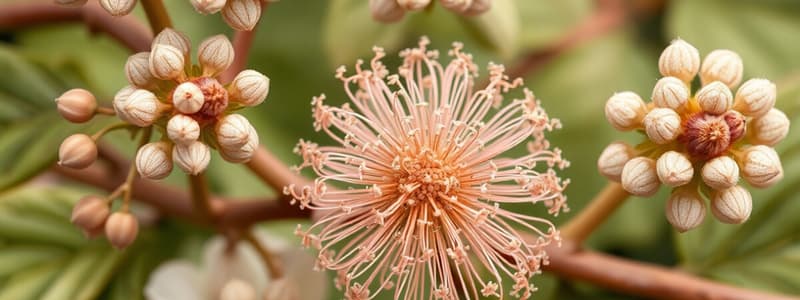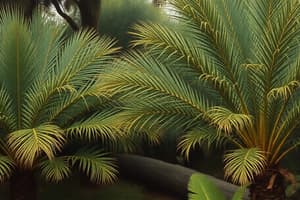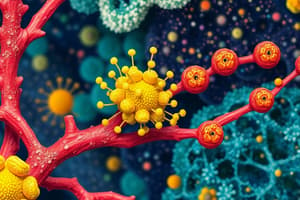Podcast
Questions and Answers
Flashcards
Pteridospermales
Pteridospermales
Ancient gymnosperms from the late Devonian period, also known as seed ferns.
Progymnosperms
Progymnosperms
Plants from the late Devonian period (370 mya) that had begun to acquire adaptations characterizing seed plants.
Pollination
Pollination
The transfer of pollen to the part of a seed plant containing the ovules.
Ovule
Ovule
Signup and view all the flashcards
Ovule
Ovule
Signup and view all the flashcards
Living Seed Plants
Living Seed Plants
Signup and view all the flashcards
Phylum Cycadophyta
Phylum Cycadophyta
Signup and view all the flashcards
Phylum Ginkgophyta
Phylum Ginkgophyta
Signup and view all the flashcards
Heterospory
Heterospory
Signup and view all the flashcards
Megaspores
Megaspores
Signup and view all the flashcards
Microspores
Microspores
Signup and view all the flashcards
Phylum Gnetophyta
Phylum Gnetophyta
Signup and view all the flashcards
Male Cone
Male Cone
Signup and view all the flashcards
Female Cone
Female Cone
Signup and view all the flashcards
Gymnosperms
Gymnosperms
Signup and view all the flashcards
Cycadophyta
Cycadophyta
Signup and view all the flashcards
Ginkgo biloba
Ginkgo biloba
Signup and view all the flashcards
Sepals
Sepals
Signup and view all the flashcards
Petals
Petals
Signup and view all the flashcards
Stamens
Stamens
Signup and view all the flashcards
Carpels
Carpels
Signup and view all the flashcards
Angiosperm
Angiosperm
Signup and view all the flashcards
Carpel
Carpel
Signup and view all the flashcards
Fruit
Fruit
Signup and view all the flashcards
Windblown seeds
Windblown seeds
Signup and view all the flashcards
Study Notes
Gymnosperm Evolution
- Ancient gymnosperms, also known as seed ferns or Pteridospermales, existed in the late Devonian period.
- Fossil evidence indicates that some plants, called progymnosperms, had begun to acquire adaptations that characterize seed plants by the late Devonian period (370 mya).
- Some progymnosperm species were homosporous, while others were heterosporous.
- Archaeopteris is an example of a progymnosperm.
Pollen and Ovule Development
- Microspores develop into pollen grains, which contain the male gametophytes.
- Pollination is the transfer of pollen to the part of a seed plant containing the ovules.
- An ovule consists of a megasporangium, megaspore, and one or more protective integuments.
- Gymnosperm megaspores have one integument, while angiosperm megaspores typically have two integuments.
Seed Development and Advantages
- A seed develops from the entire ovule.
- A seed is a sporophyte embryo, along with its food supply, packaged in a protective coat.
- Seeds offer evolutionary advantages over spores, including remaining dormant for extended periods until conditions are favorable and being transported long distances.
Gymnosperms vs. Angiosperms
- Living seed plants are divided into two clades: gymnosperms and angiosperms.
- Gymnosperms appear early in the fossil record and dominated the Mesozoic terrestrial ecosystems.
- Gymnosperms were better suited than nonvascular plants to drier conditions.
- Angiosperms evolved from gymnosperms.
Heterospory
- Ancestors of seed plants were likely homosporous, while seed plants are mostly heterosporous.
- Megasporangia produce megaspores that give rise to female gametophytes (seeds).
- Microsporangia produce microspores that give rise to male gametophytes (pollen).
Phylum Cycadophyta
- Cycads have large cones and palmlike leaves, tracheids, ovulate, and microsporangia cones on separate plants.
- Cycads thrived during the Mesozoic era, but relatively few species exist today.
- Cycad sperm is multiflagellated, and some species are pollinated by insects like beetles, similar to angiosperms.
Phylum Ginkgophyta
- This phylum consists of a single living species, Ginkgo biloba.
- Ginkgo biloba has a high tolerance to air pollution and is a popular ornamental tree.
- Ginkgo biloba sperm is also multiflagellated.
- The fleshy seed coat has a vile odor due to butanoic and hexanoic acids, found in rancid butter and Romano cheese.
Phylum Gnetophyta
- This phylum comprises three genera.
- Gnetophyte species vary in appearance, with some being tropical and others living in deserts.
- Gnetophytes have tracheids and vessel elements, lack motile sperm, and have ovulate and microsporangiate cones on separate plants.
- Ephedra, a member of this phylum, exhibits double fertilization like angiosperms but produces extra embryos instead of 3n endosperm.
Cones
- Male cones release pollen grains that rely on wind to reach a female cone.
- Female cones have ovules on protruding scales and produce seeds when fertilized by pollen.
- Wind dispersal of pollen is highly inefficient, but pines have used wind pollination successfully for over 200 million years.
Pine Life Cycle
- The pine tree is the sporophyte and produces sporangia in male and female cones.
- Small cones produce microspores called pollen grains, which contain a male gametophyte dispersed by wind..
Gymnosperm Characteristics
- Gymnosperms bear "naked" seeds, typically on cones, not enclosed by ovaries.
- The gymnosperms consist of four phyla: Cycadophyta (cycads); Ginkgophyta (Ginkgo biloba); Gnetophyta (Gnetum, Ephedra, Welwitschia); and Coniferophyta (conifers like pine, fir, and redwood).
Largest Plant on Earth
- Posidonia australis, a seagrass species that thrives off Australia's Western Coast in Shark Bay, is believed to be the largest plant on Earth.
- The plant spans over 200 square km and appears to have expanded from a single colonizing seedling.
- Scientists believe the single seed originated about 4,500 years ago and has formed a vast underground meadow home to many marine animals.
Flower Structure
- A flower is a specialized shoot with up to four types of modified leaves: sepals, petals, stamens, and carpels.
- Sepals enclose the flower.
- Petals are brightly colored and attract pollinators.
- Stamens produce pollen on their terminal anthers.
- Carpels produce ovules.
- A carpel consists of an ovary at the base and a style leading up to a stigma, where pollen is received.
Angiosperm Adaptations
- Angiosperms reproductive adaptations include flowers and fruit.
- Angiosperms are seed plants that have reproductive structures called flowers and fruits.
- Angiosperms are the most widespread and diverse of all plants.
Phylum Coniferophyta
- This phylum is the largest of the gymnosperm phyla.
- Most conifers are evergreens that can carry out photosynthesis year-round, and features tracheids and ovate and microsporangiate cones on the same plant but no motile sperm.
- Pine trees usually disperse their offspring using windblown seeds.
- Cones are modified leaves.
Flower Pollination
- Nectar and brightly colored reproductive parts attract animal dispersers.
- Mammals have skins and mucous membranes that are sensitive to phenolic secretions of plants like poison oak and ivy which inhibits herbivores, coevolution.
- White flowers are associated with nocturnal pollinators (moths and bats).
- Bright colored flowers are associated with visually oriented, diurnal pollinators (birds, butterflies, bees).
- Sweet odors attract pollinators with a good sense of smell like moths, butterflies and bees, while stinky odors attract pollinators like flies.
- Flowers with abundant nectar attract pollinators such as bees, birds, and butterflies, while those with no nectar attract flies, looking for a place to lay eggs, or insects.
Fruit and Seed Dispersal
- A fruit (the ovary) typically consists of a mature ovary but can also include other flower parts.
- Fruits protect seeds and aid in their dispersal.
- Seeds (the ovules) can be carried by wind, water, or animals to new locations.
- Frugivorous animals that eat fruit have coevolved unique adaptations.
- Seed coats need to be protected going though the digestive tract.
- Some seeds need disruption of ther seed coat to germinate ether by acid or enzyme actions.
Angiosperm Characteristics
- All angiosperms are classified in the phylum Anthophyta (Magnoliophyta).
- The name comes from the Greek word anthos, meaning flower.
- The flower is AN angiosperm structure specialized for sexual reproduction.
- Many angiosperm species are pollinated by insects or vertebrate animals, but some are wind-pollinated or use water as a vector of transport.
Studying That Suits You
Use AI to generate personalized quizzes and flashcards to suit your learning preferences.




